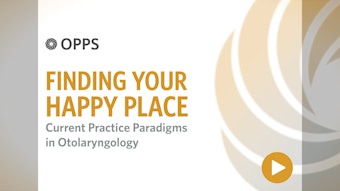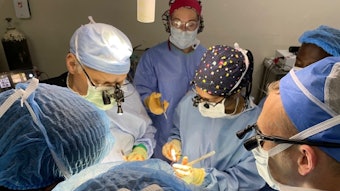Allergy Season Got a Jumpstart This Year
Otolaryngologists are uniquely positioned to manage patients suffering from allergic rhinitis. As levels of common allergens continue to rise, consider incorporating allergy testing and immunotherapy into your practice.
Cecelia Damask, DO, Chair, Allergy, Asthma and Immunology Committee

Is your waiting room already full of patients complaining of an itchy, sneezy, blocked-up nose or watery, itchy eyes? It seems as though the allergy season got a jumpstart on us this year and has been more intense all over the country. This year, we have seen very early pollen activity because we had a mild winter followed by warmth early in the season. Plants respond to this by flowering and releasing pollen.
It seems as though every year, more and more patients are seeking medical attention for spring allergies. Because of the higher pollen counts, patients are experiencing more and more symptoms. In previous years, many patients were able to tolerate their allergies and just make it through the season. But now, because spring allergies are starting earlier and lasting longer, more patients are seeking care. Seasonal exposure to pollen may induce a priming effect on the allergic response, resulting in exaggerated effects at the end of the natural pollen season. Patients experience symptoms early in the spring; then when pollen counts increase again later in the season, they get even worse symptoms.
Rising levels of CO2 in the atmosphere have been driving an increase in plant photosynthesis—an effect known as the carbon fertilization effect. Between 1982 and 2020, global plant photosynthesis grew 12%.
As those CO2 levels have been increasing in the atmosphere, plants have been given the ingredients that they need to grow more robustly and to produce more pollen. Over the past few decades, there has been a clear lengthening of the growing season. It is likely that the seasons will continue to get longer, and the amount of pollen produced will only increase.
 CO2 and rising temperatures have a synergistic effect on environmental causes of allergies.
CO2 and rising temperatures have a synergistic effect on environmental causes of allergies.
For people with allergies and/or asthma, these potential increases in the duration of the pollen seasons and the amount of pollen produced could have serious consequences and only multiply their misery. Allergic rhinitis (AR) is a comorbidity with many other diseases and conditions treated by otolaryngologists and shares significant symptom overlap with a variety of diseases relevant to our practices. Currently there is a growing need for specialists to treat allergic conditions. The Association of American Medical Colleges in its most current workforce report (2021) revealed a total of 5009 active A/I physicians in direct patient care, translating to approximately 1.0 A/I physician per 65,197 population. In 2009, 294 A/I fellows completed their fellowship training, and 1,406 otolaryngology residents completed their training.1,2
Otolaryngologists are uniquely positioned to assess for the presence of allergic disease in patients with upper aerodigestive tract symptoms. Incorporating allergy testing and immunotherapy into your practice allows you to provide comprehensive care to patients and, as an ancillary service, can help build your practice.
Adding Allergy Testing and Immunotherapy to Your Practice
Allergy diagnostic testing is one of the first services you can offer your patients. Although a presumptive diagnosis of allergic disease may be made from the patient’s history, allergy testing has several important roles. These include confirmation of the clinical diagnosis, identification of the patient’s relevant allergen sensitivities, and selection of a safe starting dose for immunotherapy.
Several different testing modalities are available. Allergen-specific IgE in the serum can be used as a marker of sensitization. An in vitro specific IgE test may be accomplished with a simple blood draw and send out to a reference laboratory. The most commonly employed allergy testing technique is skin testing. A simple prick test performed with an allergen extract and a plastic disposable device can identify preformed allergen-specific IgE via cutaneous mast cell degranulation and the classic “wheal and flare” reaction of the skin. Another technique is to use a small needle to inject diluted allergen into the dermis, looking for a similar reaction (intradermal test).
Some practices may choose to incorporate a blended technique of both prick and intradermal tests, commonly known as “modified quantitative testing.” Allergy diagnostic testing provides the clinician with important information to aid in clinical decision making and is a cornerstone in the management of allergic disease. Most otolaryngology practices should be able to add some form of allergy diagnostic testing with minimal investment.
Most patients with AR are treated with allergen avoidance and pharmacotherapy. However, allergen-specific immunotherapy is the only treatment that addresses the underlying immunologic derangement in allergic disease. Successful immunotherapy decreases symptoms and improves disease-specific quality of life3. Immunotherapy achieves these benefits via a variety of mechanisms. It reduces mast cell and basophil degranulation, induces the production of IgG4 “blocking antibody,” upregulates tolerogenic regulatory T cell populations, and reduces allergen-specific IgE over the long term. Comprehensive allergy care thus includes allergen-specific immunotherapy.
A variety of immunotherapy options are utilized in practice. The simplest method for allergen-specific immunotherapy is sublingual immunotherapy (SLIT) using FDA-approved sublingual tablets. These are available for the treatment of grass, ragweed, and dust mite allergy. Another option is SLIT utilizing a customized formulation of aqueous allergen extracts based on clinical determination of a patient’s relevant allergen sensitivities. The advantage of this approach is that allergens other than grass, ragweed, and dust mite can be treated.
Although SLIT has many advantages, the mainstay of immunotherapy in the U.S. is subcutaneous injection immunotherapy (SCIT). SCIT has the longest track record of clinical use and has been demonstrated to be effective in multiple randomized placebo-controlled trials4. SCIT is FDA approved and covered by most health insurance plans. While SLIT is used by many practices in one form or other, most allergy practices use SCIT for these reasons.
Otolaryngologists have many reasons for incorporating comprehensive allergy care into their practices. Before initiating these services, a practice should consider its goals as well as the requirements for success.
Like any other decision involving the services offered by your practice, incorporating allergy care should be undertaken with a business plan in mind. The business plan should include tangible metrics of success: monitoring of referral trends, financials, retention rates of patients, and analyzing patient outcomes. The primary financial investment when starting an allergy practice is the cost of supplies. These include allergen extracts, syringes, testing devices, and emergency supplies (for anaphylaxis treatment). Usually, the existing medical office personnel are able to take on the new roles required for allergy care. These roles include performance of allergy skin tests, preparation of testing and immunotherapy vials, and administration of immunotherapy. Medical office assistants or nurses can perform these duties depending upon individual state regulations. Ultimately, successful allergy practices will have personnel who are completely dedicated to providing these services.
Office space for the allergy practice must also be considered. A location for preparing allergen extracts needs to be defined as well as space for testing and administration of immunotherapy injections. Because SCIT carries a risk of anaphylaxis, a monitored location within the office will need to be designated for patient observation after injections are administered. When beginning an allergy practice, existing office space can be utilized. However, as the practice grows, so will requirements for space. An ideal office environment includes a dedicated check-in desk for allergy patients, a separate waiting room for observation, and an allergenic extract compounding area as well as space for testing multiple patients simultaneously and giving injections.
Although office staff perform most of the day-to-day tasks, the physician (or advanced practice provider) is the leader of the team and should be the content expert for every aspect of the allergy practice, including the nuances of testing and immunotherapy, management of allergy emergencies, regulatory and compliance issues, proper billing and coding, and documentation. This responsibility entails considerable investment of time and energy on the part of the physician. Becoming an expert in these topics can be accomplished in a variety of ways. Trusted colleagues are a potential source of information and advice. Allergy-specific CME offerings at the AAO-HNSF Annual Meeting and from other sources should be used. Read a variety of texts and monographs on allergy directed toward otolaryngologists. Talk to allergen supply vendors. And finally, enroll in a course that reviews proper billing and compliance information.
There is never an ideal time to get started on the journey of building an allergy practice. Fortunately, allergy services can be gradually added to what you are already offering your patients. It’s OK to start slowly. Allergy testing is a simple starting point. In vitro testing and skin prick testing are easy to introduce into your practice flow. Sublingual immunotherapy tablets are a safe and effective way to begin offering immunotherapy to your patients. As you and your staff learn more about allergies and become more comfortable with your knowledge and skills, you can expand to offer a full spectrum of allergy services.
References
- Gurgel RK, Baroody FM, Damask CC, et al. Clinical Practice Guideline: Immunotherapy for Inhalant Allergy. Otolaryngol Head Neck Surg. 2024 Mar;170 Suppl 1:S1-S42.
- AAMC. Physician specialty data report. 2021. Accessed March 2024. https://www.aamc.org/data-reports/workforce/data/active-physicians-largest-specialties-major-professional-activity-2021
- Wise SK, Damask C, Roland LT, et al. International consensus statement on allergy and rhinology: allergic rhinitis - 2023. Int Forum Allergy Rhinol. 2023 Apr;13(4):293-859. doi: 10.1002/alr.23090. Epub 2023 Mar 6. PMID: 36878860.
- Wise SK, Damask C, Greenhawt M, et al. A synopsis of guidance for allergic rhinitis diagnosis and management from ICAR 2023. J Allergy Clin Immunol Pract. 2023 Mar;11(3):773-796. doi: 10.1016/j.jaip.2023.01.007. PMID: 36894277.










